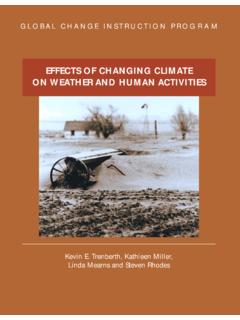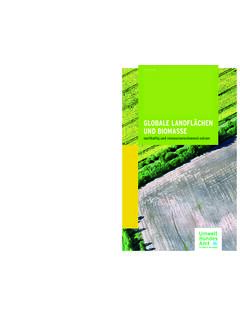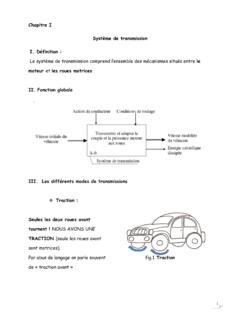Transcription of Climate change caused by human activities is happening …
1 Excerpt from Climate change caused by human activities is happening and it already has major consequences. 28 February 2018. Journal of Energy & Natural Resources Law Kevin E Trenberth Kevin E Trenberth, is a distinguished senior scientist at the National Center for Atmospheric Research, Boulder, Colorado, USA, in the Climate Analysis Section. He has been a leader in the Intergovernmental Panel on Climate change and the World Climate Research Programme. He is one of the most highly cited Climate scientists. Email: The Climate varies on multiple timescales, but now humans are the main agents of change and are likely to remain so for the next few centuries. It is generally understood that human -induced Climate change causes global warming, but what is not adequately appreciated are the direct influences on heavy rainfalls, drought, and storms, at great cost to society and the environment. Although the Climate change effects are modest, perhaps 5 to 15% for these events, once thresholds are crossed, things break and damage increases nonlinearly.
2 These aspects are not properly factored into costs of Climate change , and preparation for expected effects is woefully inadequate, exacerbating damage. 3. The Climate is changing human activities have led to the release of carbon dioxide and other heat-trapping greenhouse gases in sufficient quantity to change the composition of the atmosphere, resulting in an accumulation of heat in the Earth's system, commonly referred to as global warming . The Earth's Climate has responded through higher temperatures in the atmosphere, land and ocean, ice melting, rising sea level, and increases in extreme weather events (heat waves, wildfires, heavy rains and flooding). The calendar year 2016 is by far the warmest on record for the global mean surface temperatures (GMSTs). It easily beat out 2015, which in turn beat out the previous record holder 2014. Meanwhile, 2017 is now ranked third (or second, depending on dataset).
3 There is no doubt whatsoever that the planet is warming and it has major consequences for other aspects of Climate . However, there is also considerable natural variability manifested in the GMST record; the biggest fluctuations from year to year are associated with El Ni o events. Decadal variations led to a pause in warming from 2000. to 2013. A major El Ni o from 2015-16 somewhat inflated the GMST values, and 2017 values dropped slightly, as a result. 4. How global warming affects extreme events As well as the overall heating of the planet mainly from human changes in the atmospheric composition, which leads to general temperature increases in the atmosphere and oceans, and melting ice, there are substantial impacts on extreme events. Indeed, the biggest impacts of Climate change on society and the environment arise from changes in extremes. These are realized through the daily weather systems, which naturally produce tremendous variability on all time scales and over many different spatial scales.
4 Hence just by chance, extreme values of temperatures, precipitation, or wind, and so forth, occur from vigorous weather systems. With global warming, some of these extremes are pushed higher and beyond previous values, creating new records. Moreover, global warming often pushes values over various thresholds used for design purposes: whether for heat, rain, wind, or sea level, and accordingly things break. This also means that the events and the new records are episodic. There is not a continuous level of high values, rather the values fluctuate substantially as they have always done with natural weather patterns. It also means that in one month records are broken at one location, while in the next month records break somewhere else, and then somewhere else again. The fact 1. that the extremes occur in different places over time, means that the public often does not connect them to Climate change , and their accumulated effects have been greatly underestimated by many.
5 It also means that because of the natural Climate variability from year to year, it is often difficult to conclusively detect the Climate change influences an issue of signal-to-noise, as discussed later. 4a. Heat waves The most obvious expectation is for an increase in short-duration heat waves and their impacts as overall temperatures rise. Often these result in temperature rises beyond anything previously experienced in recorded history, and this has been borne out in many studies1 2, see also IPCC reports1 and other assessments2. Heat waves nearly always occur in association with a strong slow-moving anticyclone. The major European heat wave in the summer of 20033, was one of the first to be well documented both in terms of its detection as extremely unusual, and attribution to anthropogenic Climate change using Climate models. There were major consequences in terms of wildfires, and loss of life. A more recent example is the extreme Russian heat wave of 2010, again with widespread wildfires, smoke, agricultural losses, and loss of life.
6 Some confusion and debate has occurred in the scientific literature about this event over the cause and rarity of the weather situation, versus the role of human -induced warming4. As discussed in the next section on attribution, this confusion arises because the weather events (strong anticyclones) tend to occur naturally;. while it is the global warming that pushes what would have been an extreme event anyway into one that goes well outside previous bounds and causes major strife. High temperatures can result in detrimental health, economic, and social impacts16. The European 2003 and the Russian 2010 heat waves caused , respectively, almost 70,000 and 55,000 deaths5, while an average of 658 deaths were reported annually during 1999-2009 in the United States alone due to excessive heat6. Extreme high temperatures may cause human casualties in large cities and have profound impacts on farms due to reduced crop productivity and adverse effects on animals, including mortality.
7 Temperature extremes stress infrastructure, transportation, water supply, and electricity demand; severely affect ecosystems and forests, and increase wildfire activity. Heat strokes the most lethal condition of hyperthermia can be caused by exposure to high ambient environmental temperatures7. More frequent, more intense, and longer lasting heat waves are robustly projected in the 21st Century as a result of human -induced global warming. 1. Meehl, G. A., and C. Tebaldi, 2004: More intense, more frequent, and longer lasting heat waves in the 21st century. Science 305, 994 997. 2. Papalexiou, S. M., A. AghaKouchak, K. E. Trenberth and E. Foufoula-Georgiou, 2018: Global, Regional, and Megacity Trends in the Highest Temperature of the Year: Diagnostics and Evidence for Accelerating Trends, Earth's Future, 6, 71-79, doi: 3. Ciais, P. et al., 2005: Europe-wide reduction in primary productivity caused by the heat and drought in 2003.
8 Nature 437, 529 533. 4. Dole , R. et al. 2011: Was there a basis for anticipating the 2010 Russian heat wave? Geophys. Res. Lett., 38, L06702. Otto, F. E. L., Massey, N., van Oldenborgh, G. J., Jones, R. G. & Allen, M. R. 2012: Reconciling two approaches to attribution of the 2010 Russian heat wave. Geophys. Res. Lett. 39, L04702. Trenberth, K. E., and J. T. Fasullo, 2012: Climate extremes and Climate change : The Russian Heat Wave and other Climate Extremes of 2010. J. Geophys. Res., 117, D17103, doi: 5. Robine, et al., 2008: Death toll exceeded 70,000 in Europe during the summer of 2003. C. R. Biol. 331, 171 178. 6. Anderson, B. G. and M. L. Bell, 2009: Weather-related mortality: how heat, cold, and heat waves affect mortality in the United States. Epidemiology (Cambridge, Mass.) 20, 205. Bobb, J. F., R. D. Peng, M. L. Bell and F. Dominici, 2014: Heat-related mortality and adaptation to heat in the United States.
9 Environmental Health Perspectives (Online) 122, 811. Kochanek, K. D., J. Xu, S. L. Murphy, A. M. Mini o and Kung, 2011: Deaths: final data for 2009. Natl Vital Stat Rep 60, 1 116. 7. Smoyer-Tomic, K. E., R. Kuhn, and A. Hudson, 2003: Heat wave hazards: An overview of heat wave impacts in Canada. Natural Hazards 28, 465 486. 2. 4b. Drought and wildfire In the United States, and indeed in mid-latitude continental areas around the world, there is a strong negative correlation between monthly-mean temperatures and precipitation in the summer half year, as there is year-round in the tropics. Heat waves, especially ones of longer duration, often occur in association with drought (see Dai8 for a general discussion). The anticyclonic conditions that persist in a drought situation make for dry settled weather, with little or no precipitation. Under these circumstances, the land and vegetation dry out, and the modest extra heat from global warming exacerbates the dry conditions.
10 Evaporative cooling ceases as plants wilt, wildfire risk increases, and the heat intensifies. That in turn increases the atmospheric demand for moisture, further drying out the vegetation in a vicious cycle. The warmest year on record for the United States as a whole was 2012 when there was a widespread drought in association with persistent anticyclonic conditions over much of the country. Extreme drought was estimated to cover 39% of the country at its peak in September 2012, rivaling the Dust Bowl years in the early 1930s. According to the Sept. 4, 2012 drought monitor, 64% of the country was in moderate to extreme drought. Wildfires became endemic in many places, and firefighting costs soared9. As a result of these events and the agricultural and livestock losses, the net cost has been estimated as over $75B, although a partial accounting by NOAA lists it as $32B. Wildfire Today reports the fire-fighting costs alone in 2012 were $2B.











